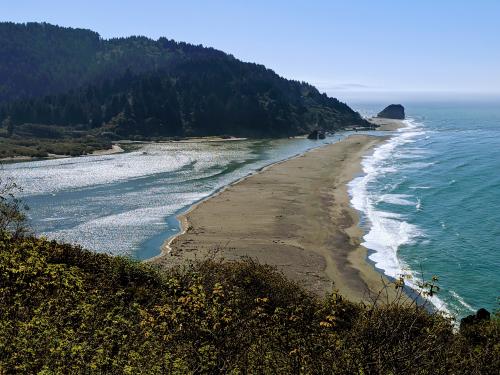The Coastal Oceanography Group at the Bodega Marine Lab conducts cutting-edge research to understand the complex physical and ecological processes shaping coastal and estuarine environments. Our work focuses on dynamic systems such as intermittently-closed estuaries, bays, and upwelling zones, as well as the impacts of climate change and sea level rise on these critical habitats. By studying fluid dynamics, water circulation, and the interactions between freshwater and marine ecosystems, we aim to advance our knowledge of coastal resilience, biodiversity, and sustainable management. Our research provides valuable insights into how coastal systems function and respond to environmental changes, guiding conservation and adaptation efforts along the California coast and beyond.
Bar-built Estuaries

Bar-built, or intermittently-closed, estuaries are dynamic coastal systems characterized by their periodic opening and closing to the ocean, typically due to the formation of sandbars or berms at their mouths. These estuaries alternate between open phases, when tidal exchange and oceanic flushing occur, and closed phases, when the mouth is blocked, trapping freshwater and altering salinity, water levels, and nutrient dynamics.
Bar-built estuaries are influenced by seasonal river flow, tidal forces, wave action, and storm events, leading to highly variable physical and chemical conditions. They provide essential habitats for fish, birds, and invertebrates, serving as nurseries and feeding grounds. However, their unique hydrology also makes them particularly sensitive to human activities, climate change, and altered freshwater inflows, impacting their ecological balance and biodiversity. Monitoring and studying these estuaries are crucial for understanding their role in coastal ecosystems and managing their health and resilience.
Related projects:
- Flooding along Sheltered Shorelines (real-time water level observations)
- Estuary Marine Protected Areas
- Russian River Long-term Monitoring
- Pescadero Estuary Long-term Monitoring
Marshes on the Margin
Bays

Bays are coastal water bodies partially enclosed by land, typically with a wide opening to the ocean, allowing for significant tidal exchange. They vary in size and shape, from large, deep basins to shallow, protected inlets, and are often characterized by calm waters sheltered from the direct impact of ocean waves. Bays provide diverse habitats, including mudflats, salt marshes, and seagrass beds, which support a wide array of marine life, including fish, shellfish, birds, and marine mammals.
The circulation patterns within bays are influenced by tides, freshwater inflows, wind, and ocean currents, creating unique environments that serve as critical feeding, breeding, and nursery grounds. Bays are ecologically and economically important, supporting fisheries, recreation, and coastal protection. However, they are also vulnerable to human impacts such as pollution, habitat loss, and climate change, making their study essential for conservation and sustainable management.
Related projects:
- San Francisco Bay
Tomales Bay
Upwelling

Upwelling is an oceanographic process in which deep, cold, nutrient-rich water rises to the surface, driven by winds that push surface waters away from the coast. This phenomenon occurs along many coastal areas, including the California coast, and is crucial for marine ecosystems, as it fuels the growth of phytoplankton, the base of the ocean food web.
Upwelling zones support some of the world’s most productive fisheries and diverse marine life, from small forage fish to top predators like seabirds and marine mammals. However, upwelling intensity and timing can be influenced by climate variability, making the study of upwelling essential for understanding its impacts on ocean health, biodiversity, and coastal economies.
Related projects:
High Frequency Radar Sea Surface Current Measurements
Sea-level Rise and Climate Change

Sea level rise is a significant consequence of climate change, driven primarily by the melting of glaciers and ice sheets and the thermal expansion of seawater as it warms. This process is accelerating, leading to higher global sea levels that threaten coastal ecosystems, infrastructure, and communities. Rising seas increase the frequency and severity of coastal flooding, erosion, and saltwater intrusion into freshwater systems, disrupting habitats and endangering species.
Climate change also intensifies extreme weather events, such as storms and heavy rainfall, further exacerbating the impacts of sea level rise on coastal areas. Understanding and monitoring these changes are crucial for developing adaptation strategies to protect ecosystems, manage coastal resources, and enhance resilience in the face of ongoing environmental challenges.
Related projects:
- Marshes on the Margin
Lakes

Lakes, though smaller and more contained than oceans, are valuable natural laboratories for studying fluid dynamics and oceanographic processes on a different scale. These inland water bodies exhibit complex circulation patterns influenced by wind, temperature gradients, inflows, and stratification, similar to coastal and open ocean systems.
Lakes experience phenomena such as internal waves, thermal stratification, and mixing, which affect nutrient distribution, oxygen levels, and aquatic life. Understanding the physical processes in lakes provides insights into broader hydrodynamic principles and helps improve models of water movement, heat transfer, and ecological interactions in larger marine and estuarine environments. Studying lakes can also reveal the impacts of climate change on thermal structure and water quality, informing broader environmental and conservation efforts.
Related projects:
- Tahoe upwelling
- Tahoe internal waves

